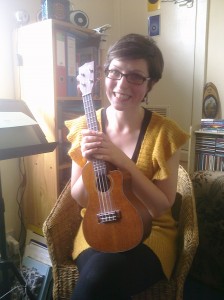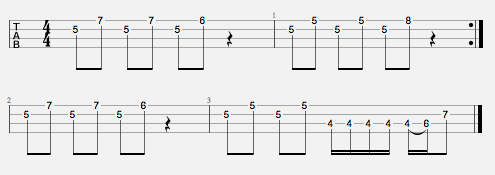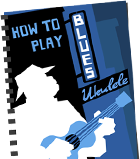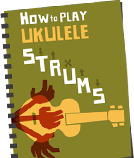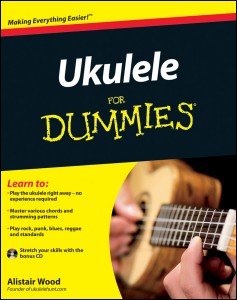 Back when I first started the blog I would bemoan the lack of beginner ukulele books. The situation has improved since then. But I still felt like there wasn’t a definitive book that covered all the important aspects of ukulele playing – particularly the way the ukulele is being played currently.
Back when I first started the blog I would bemoan the lack of beginner ukulele books. The situation has improved since then. But I still felt like there wasn’t a definitive book that covered all the important aspects of ukulele playing – particularly the way the ukulele is being played currently.
Last year the people who do the …for Dummies books made me put my balls where my blog is and actually write one myself. So for the last 9 months I’ve been working really hard to make this the best beginner’s ukulele book there is out there and now it’s available for pre-order it’s out now. You can find it cheapest (that I’ve seen) on Amazon:
Amazon US
Amazon Canada
Amazon UK
Amazon France
Amazon Germany
And in countries that don’t have Amazon:
The Niles in Australia
Fishpond in New Zealand
A quick guide to what you can expect from it.
UPDATE: Since being released, the book has had a great reaction. You can read a selection of reviews here.
How It’s Going to Make You Awesome
Back in the olden days, people learned to play a musical instrument in a pretty one-track fashion. They’d buy a book and work through it. Or they’d get a teacher and follow their syllabus. But no one learns like that any more. Everyone who learns the ukulele now plays stuff from websites and learns tunes for clubs. So the usual ukulele book that follows the old way doesn’t really work any more.
Ukulele for Dummies is more of a reference book. So – while you can certainly follow through the book in a straight line and learn to play – it works best as a book you can keep nearby and pick up when there’s a particular technique you hear about or you’re trying to play something and it doesn’t quite sound right.
For example:
A website: “Play this bit with hammer-ons.”
You: “What the flipperty-heck does that mean?”
Your Brain: “Look in Ukulele for Dummies. That will tell you.”
*A short read later.*
You: “Thanks, brain. I now know how to play hammer-ons and am thusly much more attractive to the opposite sex.”
If you’ve ever read a Dummies book before, you’ll be familiar with this idea. All the books follow that ‘modular’ pattern where you can read little sections in isolation. Same here. You can read each little bit in on its own and it’ll still make sense.
What You Get
It’s a hefty book: 360 pages all told. So it covers a lot of ground. There’s a list of contents below. Each new bit of technique will have a demonstration of it in a musical context (a lot of the time that’ll be a song or a tune). The book is written for soprano/concert/tenor. It’s not suitable for baritone ukulele.
The book comes with a 98 track CD containing all the musical examples I could cram on it.
If you’ve bought the digital version of the book you can find details of how to download the audio and video here.
Dummies Style
The book is written in the Dummies style rather than mine. The tone is still conversational and laid back. But they’re very keen to keep a consistent style between the books. So if you read something in the book that doesn’t sound like me, that’ll be because it probably wasn’t me.
The big difference is it’s safe for family use. You won’t find any of the swearing, body-part references, ironic uses of the phrase ‘off of’ and calls for an anarcho-capitalist revolution that plague this blog. And it’s also packed with gerunds if that’s your bag.
Contents
The book is put together in a way that lets you zip around and pick out the bits that interest you.
You can download an extract, the contents and the index on the Wiley site.
Part 1: Ukulele Basics
The non-playing section. Covering the fundamentals that are worth getting down before you start.
Chapter 1: Exploring the Ukulele
– Advantages of the ukulele.
– Different sizes.
– Getting to know the ukulele.
– What you can play on the ukulele.
Chapter 2: Tuning Up to Sound Great
– Basic musical terms.
– Tuning up.
– Deciding which tuning to use.
– Methods of tuning.
Chapter 3: Discovering How to Handle Your Ukulele
– Holding the ukulele.
– Preparing to strum.
– Fretting without worrying.
Part 2: Chords and Strumming
Chapter 4: Playing Your First Ukulele Chords and Songs
– Chord diagrams.
– Fretting your first chords.
– A simple strum.
Chords: Li’l Liza Jane, I’ll Fly Away, Wayfaring Stranger.
Chapter 5: Drumming Up More Strumming Patterns
– Strumming Patterns.
– Strumming in genres.
– Playing when you don’t know the pattern.
Chords: What Did the Deep Sea Say?, Shady Grove, Take Me Out to the Ballgame, House of the Rising Sun, 12 Bar Blues, Banana Boat Song (Day-O).
Chapter 6: Meeting the Chords and Their Families
– The C chord family.
– The three chord trick.
– Barre chords.
– Increasing your chord arsenal.
Chords: When the Saints Go Marching In, Man of Constant Sorrow, Irish Rover.
Part 3: Picking and Single Note Playing
Chapter 7: Getting to Grips with Tabs and Notation
– How to read tablature.
– Reading rhythms.
– Getting it all together.
Melody tabs: London Bridge Is Falling Down, I’ll Fly Away, Take Me Out to the Ballgame.
Chapter 8: Fingerpicking Patterns
– Fingerpicking technique.
– Fingerpicking patterns.
Chapter 9: Combining Chords and Melodies When Playing Solo
– Thumb strumming.
– Strumming between the melody.
– Strumming through.
– Fingerpicking.
Melody and chord tabs: London Bridge is Falling Down, Amazing Grace, In the Pines (Where Did You Sleep Last Night?), When the Saints Go Marching In, I’ll Flay Away, Freight Train.
Amazing Grace
I’ll Fly Away
When the Saints Go Marching In
Chapter 10: Picking Up Some Soloing Techniques
– Soloing techniques: hammer-ons, pull-offs, slides, bends, vibrato.
– Picking notes for solos.
– Inventing your own solos.
Part 4: Genres and Styles
This section takes the stuff from parts 2 and 3, applies it to different genres and adds new techniques.
Chapter 11: Rock and Punk
– Rock and punk chord progressions.
– Rock riffing.
– Rock soloing.
Chapter 12: Blues
– 12 bar blues variations.
– The blues shuffle.
– Blues turnaround variations.
– The blues scale in solos.
Chords: Careless Love, St James Infirmary.
Melody: Memphis Blues.
Memphis Blues
Chapter 13: Hawaiian
– Hawaiian strumming: chnking, triplet strum.
– Hawaiian turnarounds.
– Playing Hawaiian tunes.
Chords: Aloha ‘Oe,
Melody tab: Papalina Lahilahi.
Melody and chords tab: Alekoki.
Alekoki
Chapter 14: Jazz
– Jazzy chord turnarounds.
– Jazzing up chords.
– Split stroke.
– Faking a jazz solo.
Chords: Darktown Strutters’ Ball.
Tab: 12th Street Rag.
Chapter 15: Reggae and Jawaiian
– Touch strum
– Thumb ‘n strum.
– Marley-style strumming.
– Skanking.
Chords: Linstead Market.
Chapter 16: Classical
– Strumming and picking classical tunes.
– Campanella playing.
Tab: Ode to Joy, Brahms’s Lullaby, Greensleeves, Romanza, Carulli’s Andante.
Part 5: Buying and Looking After Your Ukulele
For people who don’t have a ukulele yet, this would be a good section to read first.
Chapter 17: Buying a Ukulele
– Knowing what to look for.
– Choosing where to buy.
– Buying more ukuleles.
– Going electric.
Chapter 18: Essentials and Accessories
– Finding the best strings.
– Optional accessories.
– Websites, apps and programs.
Chapter 19: Re-Stringing, Maintaining and Adjusting Your Ukulele
– When and how to restring.
– Keeping your ukulele in tiptop condition.
– Identifying and fixing problems.
Part 6: The Part of Tens
All Dummies books have a section at the end listing ten sets of things. But I can’t count.
Chapter 20: Ten Ukulele Players You Should Know
Quick profiles of:
– Ernest Ka’ai.
– May Singhi Breen.
– Roy Smeck.
– George Formby.
– The Ukulele Orchestra of Great Britain.
– Israel Kamakawiwo’ole.
– Jake Shimabukuro.
– James Hill.
– Zach Condon.
– Julia Nunes.
– I also did an ‘If you like… check out…’ who are, respectively, John King, Nellie McKay, Bob Brozman, Garfunkel and Oates, Wellington International Ukulele Orchestra, Paula Fuga, Kalei Gamaio, Paul Luongo, tUnE-yArDs and Sophie Madeleine.
Fight about those as much as you like in the comments.
Chapter 21: Ten Ways to Get Involved in the Ukulele Scene
– Joining a ukulele club.
– Visiting a ukulele festival.
– Making a video.
– Playing live.
– Going online.
– Spreading the uke news.
– Entering a contest.
– Teaching someone.
– Writing your own songs.
– Seeing a show.
Chapter 22: Ten Tips for Improving
– Playing very slowly.
– Refusing to rush things.
– Recording yourself.
– Playing with and for others.
– Practicing in sections.
– Knowing when to stop practicing.
– Steal from everyone.
– Varying your inversions and verying your invarsions.
– Opening your ears.
– Enjoying yourself.
– Busting a rut.
Appendices
Appendix A: Chord Charts
Appendix B: Reading Music
Appendix C: Using the CD
How You Can Order It
It’s due out in August and you can pre-order it in these places (and some others):
US
Amazon US
Borders
Barnes and Noble
Australia
Fishpond (Australia)
Got A Question?
Ask away in the comments.
Question Updates
Some pertinent questions from the comments:
Will there be an ebook version?
Yes, there’s going to be an enhanced, downloadable version. You can read about it on iTunes.
Will it be available in (insert language here)?
There have been discussion about translated versions. If you want to sway the decision go on the Wiley website, pick your location, contact them expressing your interest.
Neil Hannon and Joby Talbot – So Long And Thanks For All The Fish (Chords)
This has the longest chord list of any song I’ve done. That’s thanks to a key change, a choromatic middle section, some essential inversions and lashings of jazziness.
I wrote it up at the behest of Ukulelezo. She, quite sensibly, simplified it for her version by ditching the key change and the instrumental section.
Twiddly Bits
The intro sounds a bit daft on the ukulele, but – hey – it’s a daft song anyway.
The outro is dead simple:
If you’re sticking in the key of C – like Zoe does – play exactly the same thing on the g-string.
The Leftover Cuties hit it big when Game Called Life was used as the theme tune to The Big C. Last week they released their debut album Place to Go (which they kindly sent me). If you liked Game Called Life, I highly recommend you pick it up. It’s the same winning combination of instant pop melodies and jazzy setting.
My favourite aspect of the album is how comfortably the ukulele sits in the band. All the tracks on the album feature backing of the classic ukulele-upright bass pairing (along with occasional other uke-friendly instruments: brass, accordion and a smattering of stylophone). I think we’re all familiar with records that announce, “Hey, look at me, I’m playing this on a ukulele,” but here it’s used much more naturally and, therefore, pleasingly.
They’re giving away the albums title track. Grab it on this doodad or on their website:
Ukulele Cutie, Austin Nicholsen generously agreed to field a few of my questions:
How did you first get into playing the ukulele? And what made you stick with it?
I had recently purchased an upright bass and thought it would be silly to pick up the smallest string instrument at that point. I thought violin, ukulele…. ukulele it is! I walked around with it for a few days playing and trying make it sound like it was remotely in tune. Then i realized, this thing is beat. Years went by and I picked it up again and that is when it really started to resonate with me. Success! The ukulele is AWESOME! Looking back at my first encounters with the uke i realized i wasn’t ready for the awesome power of this wonderful little instrument yet.
How did you go about building a band around the ukulele? What did you have to consider?
I showed up at my good friend Shirli’s house in the middle of the night with the ukulele. I guess she had never seen one before then and didn’t know what to make of it. I don’t think she even thought it was a real instrument. Anyhow I started playing a chord progression I had been strumming on and Shirli pulled out a napkin that she had earlier wrote some lyrics on while she was working. We recorded a rough demo the next day and then it was buried for a couple of years. Little did we know that this was the beginning of something far greater than we could ever conceive at the time.
Years later Shirli stumbled across that little demo and felt something special within that little song “Game Called Life”. She played it for some friends and family and the reviews came flooding in, people wanted more of this magic. We did some more bootleg demos and people were stoked! Shortly following the band name came and we were off and running. It was time for this little seed to grow. We decided it was time for higher quality recordings. We met with a great man named Ryan Hewitt who recorded and produced our EP and he said you’re going to need drums if you want to sell records. One man came to my mind for this musical adventure, Stuart Johnson. One of the greatest and most musical drummers in the world without a doubt.
Next came the proper low end bass player, Ryan Feves. A great man who in my mind is a world class bassists, amazing feel and tone that warms your insides. The family kept growing, it took a bit before we found the missing piece but it was worth the wait. Mike Bolger, what can’t the guy do. I mean really, he plays piano, accordion, all brass and who knows what else. But get this he can play them at the same time, that’s right piano in left hand, trumpet in right. I believe this guy has been on a million recordings, maybe more. Oh yeah and he really smokes a mean BBQ, grille master extraordinaire! No consideration when it all started because the uke was the foundation.
What’s in your ukulele collection? Any favourites?
My main uke is an old Kamaka pineapple uke, my guess is 1930 or 31, # 5416 9 – maybe someone out there can help determine the year. I hold this uke near and dear to my heart, I have picked up few ukes that can even come close to the tonal quality.
Also have a label free soprano uke with great tone but chunky fretts, still cool though. And an old soprano supertone from Sears Roebuck and Co. from maybe the 40’s, very fragile little mahogany uke with a cheerful tone. A cookie tin uke that i frankensteined together using a banjolele neck that would never ever stay in tune no matter what and a holiday cookie tin with a wreath on it. An old May bell banjolele from the early 1930’s. A Cigar box uke that I ripped the neck off my first label free Chinese uke for, kind-of dead sounding. A Tahitian uke with fishing line for strings ( a bit bitty ) and last but not least, also not really a ukelele, an old Wurlitzer Tiple made by C.F. Martin from the late 20’s.
The pineapple takes the cake!!!!! Every time
As well as a love of ukes, we’re both enthusiastic cap wearers. What do you look for a good cap?
Comfort and versatility.
What can we expect to hear from the Leftover Cuties in the future?
Who knows what’s in store for us, the sky’s the limit! I am pushing for some remixes on this album. Also there is a lot of great new material on the burner already!
And an entirely selfish question: any plans to visit the UK?
Absolutely!!!!! Some day for sure – hopefully soon.
Visit LeftoverCuties.com. Buy the album on iTunes.
Videos this week include the new one from Eddie Vedder, podcast star Helen Arney (you can download this song and a couple of others on Bandcamp for free if you make it before it runs out), Lemos and a houseful of buddies, auto-erotica from Garfunkel and Oates and plenty more besides.
After last week’s Window Shopping post I got a few complaints about the insane prices of the ukuleles featured. Looking solely at ukuleles I’m too poor to afford is the only way to ensure I don’t end up buying one. But this week I put my wallet in peril for you and look at what I’d buy at the lower end of the market.
Under $25: I’d have to go with a Pink Mahalo U-30 and hope I got a good one. Yes, pink. I need a uke that’s going to match this shirt.
But I’d be tempted by: A Practical Method for Self Instruction on The Ukulele by N.B. Bailey. I love old ukulele instruction books.
Under $50: I don’t own a pineapple ukulele so I’d go with a Makala Pineapple.
But I’d be tempted by: The Wolfelele.
Under $75: If I didn’t already have a Mahalo Les Paul, I’d definitely be getting one of those. Otherwise, perhaps an old Harmony.
But I’d be tempted by: A ukulele teapot with intestine handle.
Under $100: The sensible choice would be Kala Mahogany Concert. But the Plaid Kala Ukadelic to garish-up my collection nicely.
But I’d be tempted by: This adorable pair of beaten up banjoleles that I’d never get round to having fixed up.
Under $150: It would have to be an Ohana Vita uke in tribute to Roy Smeck.
But I’d be tempted by: This Soul Cat cigar box ukulele.
Leave your suggestions/shopping list in the comments.
A flurry of F-words, gaffes and misinformation as the British media has gone on one of their ‘the ukulele is making a comeback’ kicks (as they’ve done a couple a times a year for the last five years). A selection of the goings-on:
– The most amusing was in the Telegraph which was originally sub-headlined, “The ukulele is hard to take seriously thanks to its association with George Forman.”
– The Daily Mail originally had it, “It seems there are several theories as to why the ukelele – or ‘uku’ as it is nicknamed – is enjoying a revival.”
– Michael White laid into the UOGB’s Proms performance pretty viciously (despite being quite positive about it at the time).
– Huffington Post illustrated the story with a picture of Sting playing a guitar.
– The Express headlined “Now the ukulele outsells electric guitars,” but quotes figures that don’t seem to back that up.
– The Guardian reckon it’s only possible to play the ukulele (or ‘ukukele’) like George Formby: “Something in the posture required to play the ukulele – shoulders hunched, elbows akimbo – probably encouraged a perky grinning manner: it’s probably impossible to play the ukukele in any other way.”
– And on TV: Channel 4 News and on Daybreak (with Lorraine managing to knock out Sweet Child of Mine at 6:30am).
– One interesting fact in the brouhaha:
180 music shops were surveyed with 42 per cent saying the ukulele had seen the biggest rise in popularity in the last year. 31 per cent stated that keyboards had seen the largest growth, and 16 per cent for acoustic guitars.
I need to calm down after that epic bitch-fest with some Bigfoot and Tiki cartoons.
The UOGB present the Ukulele Podcast of Great Britain with a guest appearance from Glenn Tilbrook. And here’s Will playing what he claims is the world’s smallest playable ukulele (which Alvin Okami may take issue with) (thanks to Ron).
Vo-do-de-o Days charts the history of Tiptoe Through the Tulips.
The Wellington International Ukulele Orchestra are on iTunes.
Lots of intriguing pictures from the Tokyo Hand Craft Guitar FES.
The ukulele bit on Cougar Town (thanks to Anna). If you’re in a location-blocked country you can still watch Josh Hopkins having a bit of a uke here.
Ari Pulkkinen – Angry Birds (Tab)
Angry Birds might be annoyingly addictive and sometimes annoyingly annoying, but the theme music is outstanding. It’s one of two games I play and don’t turn the music off for (the other is Pizza Boy).
For my version, I did mess around with things a bit. The intro section is picked with a bit of running man picking (alternating index and middle). The main section is mostly played with the thumb flicking down on the g and C and the index finger flicking up (which a few strums thrown in). In the final section, Thumb on g, index on E and middle finger on A.
Lead Sheet
Here’s just the basic melody and it’s a bit more faithful to the original. So you can play it simply as it is or arrange your own version around it.
Ari Pulkkinen – Angry Birds Theme (Lead Tab)
Here’s how it sounds by itself.
The May 2011 edition of the podcast is here. Helen Arney very kindly took time out of her tour with the Uncaged Monkeys to have a hilarious chinwag with Bossarocker and play a few songs. As well as that there’s a bumper crop of songs.
You can get the latest Uke Hunt podcast delivered straight to you by:
Subscribing on iTunes
RSS Feed
Adding to Google
You can get in touch and submit tracks for consideration via:
Facebook
Soundcloud
Email at podcast@ukulelehunt.com
Playlist:
1. Ukulollo – The Beat of the Strum
2. Aaron Keim – Wandering Boy
3. Ruth Acuff – Nightingale
4. The Mother Ukers – Lucifer
5. All Young Girls Are Machine Guns – Swing Back Baby Blues
6. Helen Arney (in session) – Christmas Love Song
7. Helen Arney (in session) – Strong Woman With A Broken Heart
8. Helen Arney (in session) – The Perfect Boy
9. Martin White & the Mystery Fax Machine Orchestra – Four Minutes & Thirty Three Seconds
10. Howlin’ Hobbit – 20th Century Fads
11. Shiny and the Spoon – Black Nag
12. Arch Larizza – I Don’t Need Another Ukulele
Jonathan Coulton and GLaDOS – Want You Gone (Chords)
Site update: I moved the site to a new host over the weekend which is why you may not have been able to get on it. Hopefully, things have shaken out now. If you’re reading this by email or feedreader and can’t get on the site please do send me an email at ukulelehunt@gmail.com. Or if you notice anything else that’s wonky. Thanks!
***************SPOILER ALERT***************SPOILER ALERT*********************
Portal 1 is easily the best satire of working for a large corporation with all the jumping through hoops, monitoring, lies and promises of far off rewards. It’s a shame games rarely go for satire because they’re one of the best mediums for it.
Portal 2 does a similar job by making us forget everything we learn in Portal 1 and make us put power in the hands of one being and hope that this time everything will be cool. Replicating the hope-over-experience of countries who sell arms to non-democratic countries and organisations again and again and again and again and again each time saying, “You better turn out to be pretty cool or I’m going to be pissed.” I could easily go on and on about the game but I should move on to the song.
No ukulele this time and it doesn’t transfer entirely happily. But you can still make a good fist of it.
Twiddly Bits
You can play the little riff like this:
Suggested Strumming
I think the riff sounds better on uke if you include the chords with it (shown in the chord chart). That beefs it up a bit and means you can play it an octave lower. You can strum this for the first chord in the riff:
d – d – d – d u
Then switch to this for the next chord:
d – d –
Then stop.
That sounds like this:
In the chorus you can just switch between the usual F# and B chord shapes, but the ones shown keep the ascending sound. Either way, you can use this strumming pattern:
d – d – d u d u
Once for each chord.



